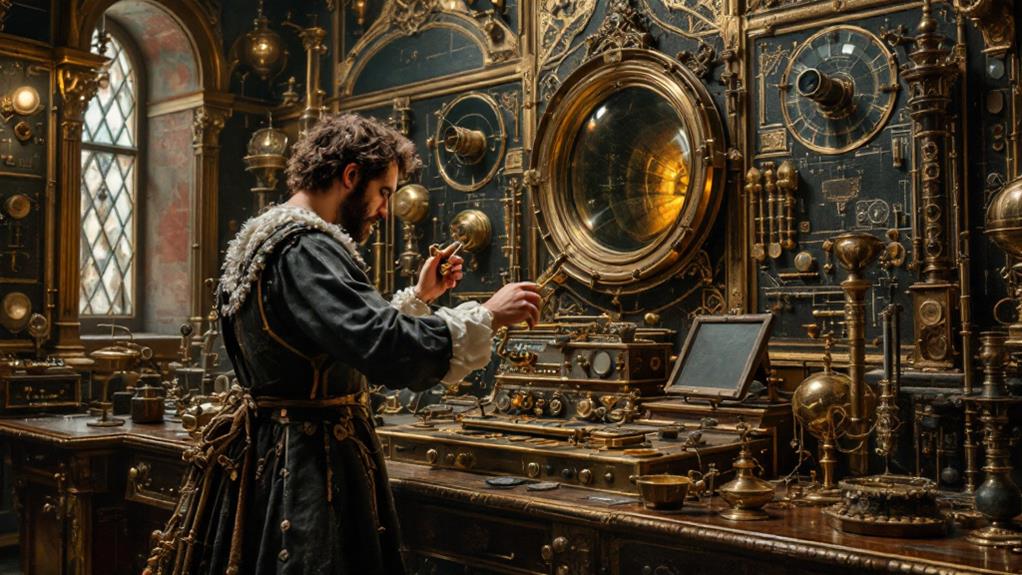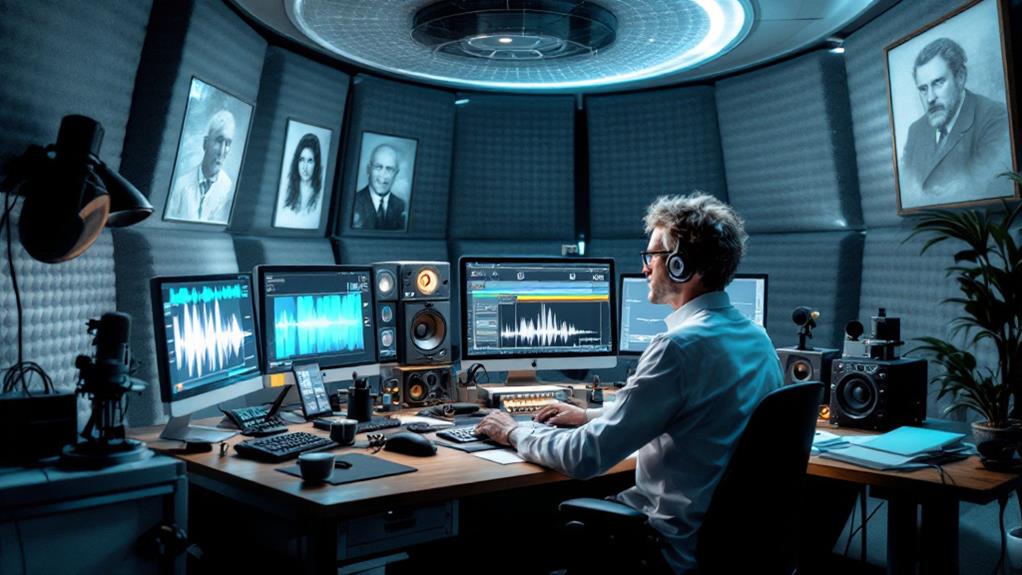The History of Acoustics: Understanding Sound Through the Ages

The history of acoustics spans millennia, from ancient philosophers to modern scientists. You'll find that early thinkers like Pythagoras and Aristotle laid the groundwork, investigating pitch and sound waves. Medieval times saw monastic sound practices and minstrel adaptations, while the Renaissance brought architectural acoustics and key scientific discoveries. The Industrial Revolution spurred noise reduction efforts and modern acoustic disciplines. Today, digital technologies have revolutionized sound creation and manipulation. Architects and engineers collaborate to shape auditory experiences, while researchers push boundaries in psychoacoustics and 3D audio. As you venture further, you'll uncover a fascinating expedition of human ingenuity in understanding and utilizing sound.
Ancient Acoustic Theories
Ancient civilizations investigated the mysteries of sound long before modern science took shape. You'll find that early Greek philosophers like Pythagoras and Aristotle were among the first to theorize about acoustics. Pythagoras uncovered the relationship between string length and pitch, laying the groundwork for understanding sonic resonance. Aristotle proposed that sound traveled through air in waves, a concept that wasn't far from the truth.
In ancient China, scholars examined the connection between music and cosmic harmony. They developed complex theories about the relationship between musical notes and natural phenomena. Meanwhile, in India, ancient texts like the Natya Shastra discussed the properties of sound and its effects on human emotions.
Ancient musical instruments provide tangible evidence of early acoustic knowledge. The design of lyres, flutes, and drums across cultures shows an intuitive understanding of how shape and material affect sound production. You can see this in the carefully crafted resonance chambers of ancient Egyptian harps or the precisely tuned bronze bells of China.
These early theories and practices laid the foundation for future acoustic discoveries, bridging the gap between mystical interpretations and scientific understanding of sound.
Medieval Sound Explorations
As we traverse into the Middle Ages, you'll find that acoustic exploration didn't stop with ancient civilizations. Medieval scholars and practitioners continued to build upon earlier knowledge, developing new theories and applications of sound.
In monasteries across Europe, monks cultivated unique acoustic practices. You'd hear them chanting in vast, echoing spaces, purposefully designed to amplify their voices and create an ethereal atmosphere. These monastic sound practices weren't just for spiritual purposes; they also served as early experiments in acoustics.
Outside the monastery walls, traveling minstrel performances became a dynamic part of medieval culture. These wandering musicians adapted their techniques to various environments, from lively town squares to noble courts. They'd adjust their volume, pitch, and delivery based on the acoustic properties of each space.
Medieval instrument makers also contributed to acoustic advancements. They'd experiment with different materials and shapes to create instruments with improved sound quality and projection. You'd see innovations in stringed instruments, wind instruments, and percussion, each designed to produce specific tonal qualities.
Renaissance Acoustic Discoveries

From out of the Middle Ages emerged the Renaissance, a period of exceptional scientific and artistic growth that considerably advanced acoustic understanding. During this time, you'd have witnessed a surge in curiosity about sound and its properties. Scientists and artists alike delved into the intricacies of cathedral resonance, exploring how architectural design influenced sound propagation. They probed into the nuances of these grand structures, discovering that the shape and materials used significantly affected acoustics.
Musical instrument design also saw remarkable progress. Craftsmen experimented with new materials and shapes, leading to innovations in stringed and wind instruments. You'd have been amazed by the improved tonal quality and range of these new creations.
Key Renaissance acoustic discoveries included:
- The relationship between pitch and frequency
- The concept of sound waves
- The speed of sound in different mediums
- Harmonics and overtones
- The principles of reverberation
These advancements laid the groundwork for modern acoustics. You'd have seen scientists like Galileo Galilei and Marin Mersenne making significant contributions to the field. Their work on vibrating strings and sound propagation paved the way for future developments in acoustics, setting the stage for the scientific revolution that followed.
Industrial Revolution Sound Advancements
The Industrial Revolution brought about a seismic shift in acoustic advancements. As factories sprang up across cities, the cacophony of machinery presented new challenges in sound management. You'd have noticed the urgent need for factory machinery noise reduction, as workers faced unprecedented levels of industrial din.
Engineers and inventors rose to the occasion, developing innovative solutions to combat noise pollution. Acoustic insulation advancements became a priority, with materials like cork, felt, and asbestos being used to dampen sound in both industrial and residential settings. You'd have seen the introduction of sound-absorbing panels and barriers in factories, significantly improving working conditions.
The era also saw the birth of modern acoustics as a scientific discipline. Pioneers like Hermann von Helmholtz and Lord Rayleigh made revelatory discoveries about sound wave behavior and resonance. Their work laid the foundation for future developments in architectural acoustics and sound engineering.
You'd have witnessed the emergence of new professions dedicated to sound management, as businesses recognized the importance of creating quieter, more productive environments. This period set the stage for the acoustic technologies we rely on today.
Modern Acoustics Pioneers

Building upon the foundations laid in the Industrial Revolution, modern acoustics pioneers pushed the field into new frontiers. You'll find that these innovators revolutionized audio engineering techniques and developed modern acoustic models that shape our understanding of sound today.
In the mid-20th century, you'd have witnessed the emergence of groundbreaking research in room acoustics, psychoacoustics, and electroacoustics. Pioneers like Leo Beranek and Manfred Schroeder made significant contributions to architectural acoustics, while James Flanagan advanced speech analysis and synthesis.
As you investigate the work of these modern acoustics pioneers, you'll uncover:
- Innovative sound measurement tools
- Advanced computer modeling for acoustic prediction
- Cutting-edge noise control methods
- Breakthroughs in acoustic materials
- Revolutionary audio reproduction technologies
You'll also notice how their work has impacted various industries, from music production to telecommunications. These pioneers' efforts have led to the development of sophisticated audio systems, improved concert hall designs, and enhanced noise reduction technologies. Their contributions continue to shape the way you experience sound in your daily life, from the clarity of your phone calls to the immersive experience of your favorite music venues.
Digital Age Sound Technologies
With the dawn of the technological epoch, sound technologies have undergone a revolutionary metamorphosis. You've witnessed the transition from analog to digital, ushering in a novel era of audio manipulation and reproduction. Digital signal processing has enabled unparalleled control over sound, allowing you to shape and mold audio with surgical precision.
The advent of immersive audio experiences has transformed how you interact with sound. Surround sound systems, once limited to movie theaters, now grace living rooms worldwide. You're enveloped in three-dimensional soundscapes that blur the line between reality and virtual environments. Spatial audio technologies have further enhanced this immersion, creating a sense of depth and directionality that was previously unattainable.
AI-powered sound design is pushing the boundaries of what's possible in audio production. You're now able to generate realistic sound effects, compose music, and even recreate voices using machine learning algorithms. These advancements have democratized sound creation, putting professional-grade tools in the hands of enthusiasts and independent creators. As technology continues to evolve, you can expect even more innovative ways to capture, manipulate, and experience sound in the digital frontier.
Acoustics in Architecture

From digital sound manipulation to physical spaces, acoustics play an essential role in shaping our auditory experiences. In architecture, you'll find that sound is a critical consideration when designing buildings. Architects and acoustic engineers work together to create spaces that enhance or control sound, depending on the building's purpose.
Architectural acoustics design involves careful planning of room shapes, materials, and surfaces to achieve desired sound qualities. You'll encounter various sound isolation techniques in modern buildings, such as:
- Double-paned windows to reduce external noise
- Floating floors to minimize vibrations
- Sound-absorbing panels in ceilings and walls
- Angled surfaces to direct sound waves
- Strategic placement of HVAC systems to reduce noise
These methods help create conducive environments for different activities, from concert halls to office spaces. You'll notice that well-designed acoustic spaces can improve communication, concentration, and overall comfort. In recent years, there's been a growing emphasis on sustainable acoustic solutions, integrating eco-friendly materials and energy-efficient designs. As you investigate different buildings, you'll start to appreciate the intricate balance between form and function in architectural acoustics.
Future of Sound Research
As we look ahead, the future of sound research promises exciting developments that'll reshape our understanding and experience of acoustics. You'll witness advancements in emerging audio synthesis techniques, enabling the creation of personalized soundscapes and virtual instruments. These innovations will revolutionize music production, sound design, and audio engineering across various industries.
Immersive sound environments will become more sophisticated, blurring the lines between reality and simulation. You'll find yourself surrounded by 3D audio experiences in virtual and augmented reality applications, enhancing gaming, education, and entertainment. Researchers are also exploring ways to manipulate sound waves for practical purposes, such as noise cancellation in urban environments and improved acoustic imaging for medical diagnostics.
The integration of artificial intelligence and machine learning in acoustics will lead to smarter sound systems that can adapt to different environments and user preferences. You'll experience individualized audio experiences customized to your unique hearing profile and listening habits. As technology continues to evolve, you can expect pioneering discoveries in psychoacoustics, helping us better understand how sound affects human cognition and emotions.



